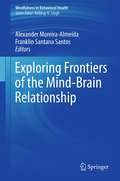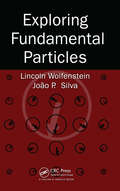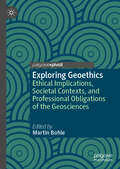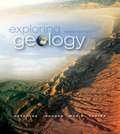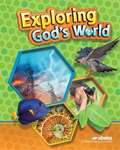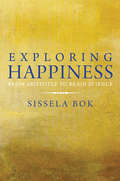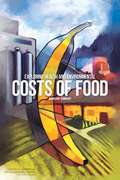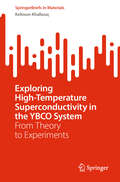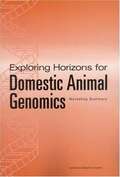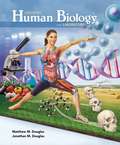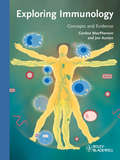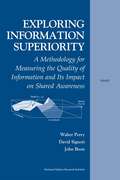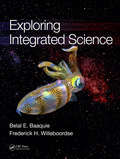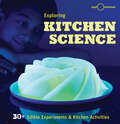- Table View
- List View
Exploring Frontiers of the Mind-Brain Relationship
by Alexander Moreira-Almeida Franklin Santana SantosThe conscious mind defines human existence. Many consider the brain as a computer, and they attempt to explain consciousness as emerging at a critical, but unspecified, threshold level of complex computation among neurons. The brain-as-computer model, however, fails to account for phenomenal experience and portrays consciousness as an impotent, after-the-fact epiphenomenon lacking causal power. And the brain-as-computer concept precludes even the remotest possibility of spirituality. As described throughout the history of humankind, seemingly spiritual mental phenomena including transcendent states, near-death and out-of-body experiences, and past-life memories have in recent years been well documented and treated scientifically. In addition, the brain-as-computer approach has been challenged by advocates of quantum brain biology, who are possibly able to explain, scientifically, nonlocal, seemingly spiritual mental states. Exploring Frontiers of the Mind-Brain Relationship argues against the purely physical analysis of consciousness and for a balanced psychobiological approach. This thought-provoking volume bridges philosophy of mind with science of mind to look empirically at transcendent phenomena, such as mystic states, near-death experiences and past-life memories, that have confounded scientists for decades. Representing disciplines ranging from philosophy and history to neuroimaging and physics, and boasting a panel of expert scientists and physicians, including Andrew Newberg, Peter Fenwick, Stuart Hameroff, Mario Beauregard, Deepak Chopra, and Chris Clarke the book rigorously follows several lines of inquiry into mind-brain controversies, challenging readers to form their own conclusions--or reconsider previous ones. Key coverage includes: Objections to reductionistic materialism from the philosophical and the scientific tradition.Phenomena and the mind-brain problem.The neurobiological correlates of meditation and mindfulness.The quantum soul, a view from physics.Clinical implications of end-of-life experiences.Mediumistic experience and the mind-brain relationship. Exploring Frontiers of the Mind-Brain Relationship is essential reading for researchers and clinicians across many disciplines, including cognitive psychology, personality and social psychology, the neurosciences, neuropsychiatry, palliative care, philosophy, and quantum physics. "This book ... brings together some precious observations about the fundamental mystery of the nature of consciousness ... It raises many questions that serve to invite each of us to be more aware of the uncertainty of our preconceptions about consciousness ... This book on the frontiers of mind-body relationships is a scholarly embodiment of creative and open-minded science." C. Robert Cloninger, MD Wallace Renard Professor of Psychiatry, Genetics, and Psychology, Washington University School of Medicine St. Louis MO
Exploring Fundamental Particles
by Lincoln Wolfenstein Joao P. SilvaThe search for the elementary constituents of the physical universe and the interactions between them has transformed over time and continues to evolve today, as we seek answers to questions about the existence of stars, galaxies, and humankind. Integrating both theoretical and experimental work, Exploring Fundamental Particles traces the developme
Exploring Geoethics: Ethical Implications, Societal Contexts, and Professional Obligations of the Geosciences
by Martin BohleThis book explores the potential of geoethics, as designed within the operational criteria of addressing the deeds and values of the human agent as part of the Earth system. It addresses three key questions: i) what should be considered 'geoethics' in an operational sense, ii) what is peripheral to it, and iii) is there a case therefore to establish a denomination, such as geo-humanities or geosophy, to capture a broader scope of thinking about geoscience and its interactions with society and the natural world, for the benefit of the geo-professionals and others.The book begins by framing, contextualising and describing contemporary geoethics, then goes on to cover several examples of geoethical thinking and explores the societal intersections of geosciences in the planetary ‘human niche’. The concluding chapter discusses the challenges facing the emerging field of geoethics and how it may evolve in the future. Bringing together a set of experts across multiple interdisciplinary fields this collection will appeal to scholars, researchers, practitioners and students within geosciences and social sciences, political sciences as well as the humanities. It will interest those who are curious about how ethical reflections relate to professional duties, scholarly interests, activities in professional geoscience associations, or responsible citizenship in times of anthropogenic global change.
Exploring Geology (Third Edition)
by Stephen Reynolds Charles M. Carter Julia Johnson Paul MorinExploring Geology by Reynolds/Johnson/Kelly/Morin/Carter is an innovative textbook intended for an introductory college geology course, such as Physical Geology. This ground-breaking, visually spectacular book was designed from cognitive and educational research on how students think, learn, and study. Nearly all information in the book is built around 2,600 photographs and stunning illustrations, rather than being in long blocks of text that are not articulated with figures. These annotated illustrations help students visualize geologic processes and concepts, and are suited to the way most instructors already teach. To alleviate cognitive load and help students focus on one important geologic process or concept at a time, the book consists entirely of two-page spreads organized into 19 chapters. Each two-page spread is a self-contained block of information about a specific topic, emphasizing geologic concepts, processes, features, and approaches. These spreads help students learn and organize geologic knowledge in a new and exciting way. Inquiry is embedded throughout the book, modeling how geologists investigate problems. The title of each two-page spread and topic heading is a question intended to get readers to think about the topic and become interested and motivated to explore the two-page spread for answers. Each chapter is a learning cycle, which begins with a visually engaging two-page spread about a compelling geologic issue. Each chapter ends with an Investigation that challenges students with a problem associated with a virtual place. The world-class media, spectacular presentations, and assessments are all tightly articulated with the textbook. This book is designed to encourage students to observe, interpret, think critically, and engage in authentic inquiry, and is highly acclaimed by reviewers, instructors, and students.
Exploring God’s World
by Judy Hull Moore Hilary HastyThis teaching text includes a copy of the student book with answers inserted throughout. It also includes added teaching helps such as lesson plans, notes on vocabulary, and introductions to concepts, oral reading applications, comprehension questions, and discussions to help you explain complex concepts on an age appropriate-level. The extra activities included that you can use to help your child apply scientific concepts to real life. This book helps present information in a logical order and give your child a better understanding of science.
Exploring Happiness: From Aristotle to Brain Science
by Sissela BokFrom the acclaimed author of Lying, a brilliant exploration of happiness set in the context of the world’s great philosophers, leaders, writers, and artists In this smart and timely book, the distinguished moral philosopher Sissela Bok ponders the nature of happiness and its place in philosophical thinking and writing throughout the ages. With nuance and elegance, Bok explores notions of happiness—from Greek philosophers to Desmond Tutu, Charles Darwin, Iris Murdoch, and the Dalai Lama—as well as the latest theories advanced by psychologists, economists, geneticists, and neuroscientists. Eschewing abstract theorizing, Bok weaves in a wealth of firsthand observations about happiness from ordinary people as well as renowned figures. This may well be the most complete picture of happiness yet.This book is also a clarion call to think clearly and sensitively about happiness. Bringing together very different disciplines provides Bok with a unique opportunity to consider the role of happiness in wider questions of how we should lead our lives and treat one another—concerns that don’t often figure in today’s happiness equation. How should we pursue, weigh, value, or limit our own happiness, or that of others, now and in the future? Compelling and perceptive, Exploring Happiness shines a welcome new light on the heart of the human condition.
Exploring Health and Environmental Costs of Food: Workshop Summary
by Leslie PrayThe U. S. food system provides many benefits, not the least of which is a safe, nutritious and consistent food supply. However, the same system also creates significant environmental, public health, and other costs that generally are not recognized and not accounted for in the retail price of food. These include greenhouse gas (GHG) emissions, soil erosion, air pollution, and their environmental consequences, the transfer of antibiotic resistance from food animals to human, and other human health outcomes, including foodborne illnesses and chronic disease. Some external costs which are also known as externalities are accounted for in ways that do not involve increasing the price of food. But many are not. They are borne involuntarily by society at large. A better understanding of external costs would help decision makers at all stages of the life cycle to expand the benefits of the U. S. food system even further. The Institute of Medicine (IOM) and the National Research Council (NRC) with support from the U. S. Centers for Disease Control and Prevention (CDC) convened a public workshop on April 23-23, 2012, to explore the external costs of food, methodologies for quantifying those costs, and the limitations of the methodologies. The workshop was intended to be an information-gathering activity only. Given the complexity of the issues and the broad areas of expertise involved, workshop presentations and discussions represent only a small portion of the current knowledge and are by no means comprehensive. The focus was on the environmental and health impacts of food, using externalities as a basis for discussion and animal products as a case study. The intention was not to quantify costs or benefits, but rather to lay the groundwork for doing so. A major goal of the workshop was to identify information sources and methodologies required to recognize and estimate the costs and benefits of environmental and public health consequences associated with the U. S. food system. It was anticipated that the workshop would provide the basis for a follow-up consensus study of the subject and that a central task of the consensus study will be to develop a framework for a full-scale accounting of the environmental and public health effects for all food products of the U. S. food system. Exploring Health and Environmental Costs of Food: Workshop Summary provides the basis for a follow-up planning discussion involving members of the IOM Food and Nutrition Board and the NRC Board on Agriculture and Natural Resources and others to develop the scope and areas of expertise needed for a larger-scale, consensus study of the subject.
Exploring High-Temperature Superconductivity in the YBCO System: From Theory to Experiments (SpringerBriefs in Materials)
by Keltoum KhallouqThe book explores the properties and behaviors of high-critical-temperature superconductors in the yttrium barium copper oxide (YBCO) system, looking specifically at Y0.5Ln0.5BaSrCu3O6+z compounds, where Ln represents rare earth elements like europium (Eu), samarium (Sm), and (neodymium) Nd. Structured into several chapters, it navigates through key aspects of superconductivity and its characterization. Starting with an introduction to the discovery of high-critical-temperature superconductors and their far-reaching applications, it sheds light on unresolved questions in materials physics, particularly concerning the behavior of the copper(II)-oxide (CuO2) planes and the introduction of additional electronic holes. Emphasizing the pivotal role of the CuO2 planes in shaping material properties above the critical temperature, it also delves into the history of superconductivity, properties of superconducting materials, and various types of superconductors. Phenomenological theories like the London theory, Ginzburg-Landau theory, and Abrikosov's theory of the mixed state in type II superconductors are discussed, along with conventional theories such as the BCS theory and Josephson junctions. The book provides an overview of experimental techniques used to characterize structural, magnetic, and electrical properties of superconductor compounds, including X-ray diffraction, scanning electron microscopy, and magnetometry. Focusing on the structural, magnetic, and electrical properties of Y0.5Ln0.5BaSrCu3O6+z compounds, along with the effects of substitutions and thermal treatments, the book aims to achieve several objectives. These include a comparative study of superconducting and structural properties under various thermal treatments and isovalent substitutions, analysis of magnetic susceptibility and electrical resistivity as functions of temperature, investigation of the evolution of mixed-state properties with changing temperatures, and utilization of the Rietveld crystallographic refinement method to establish correlations between interatomic distances and critical temperatures. Additionally, the book presents the synthesis of studied compounds through solid-state reactions and subsequent thermal treatments, including annealing under oxygen and argon atmospheres. The results of these treatments are discussed in relation to improvements in irreversibility lines, magnetic shielding, and grain quality.
Exploring Horizons for Domestic Animal Genomics: Workshop Summary
by Board On Agriculture Natural ResourcesA report on Exploring Horizons for Domestic Animal Genomics
Exploring Human Biology In The Laboratory
by Matthew Douglas Jonathan DouglasExploring Human Biology in the Laboratory is a comprehensive manual appropriate for human biology lab courses. This edition features a streamlined set of clearly written activities. These exercises emphasize the anatomy, physiology, ecology, and evolution of humans within their environment. Features include the following: Beautiful, full-color, and clearly labeled illustrations and photographs; clearly stated student objectives; meaningful and engaging laboratory activities with generous space for recording data, sketches, and answers to questions; friendly and accessible writing style; Does it matter? sections open and close each chapter to give students applications of the chapter content to their daily lives; each chapter ends with a Summary and Discussion to allow students review the main points prior to completing the lab; Review Questions at the end of each chapter foster understanding of important concepts; instructor s manual with lab preparation information
Exploring Immunology
by Jon Austyn Gordon MacphersonThis concise introductory textbook uses carefully chosen examples from clinical and experimental observations to provide an insight into the principles underlying the immune system. As a result, it encourages readers to ask critical questions in order to further advance our understanding of this unique organ. Both authors are experienced lecturers and highly regarded researchers. The book is professionally illustrated in four color throughout with beautiful artwork which by itself distinguish the title from any comparable title. Website: www. wiley-vch. de/home/immunology
Exploring Information Superiority
by Walter L. Perry John E. Boon David SignoriAssessing how technology contributes to information superiority and decision dominance a major challenge, in part because it demands quantitative measures for what are usually considered qualitative concepts. The authors have developed a mathematical framework to aid these efforts. Additional work, such as data fitting, experimentation, linking decisions and actions, historical analysis, and gaming will further advance knowledge in this area.
Exploring Integrated Science
by Belal E. Baaquie Frederick H. WilleboordseWhy is rubber elastic? Why are leaves green? Why can a gecko climb a wall? Answering these and a myriad of other puzzles of nature, Exploring Integrated Science shows how the simplest questions that arise from our daily experiences can lead us through a chain of reasoning that explains some of the most fascinating principles of science.Written in a
Exploring Kitchen Science: 30+ Edible Experiments & Kitchen Activities
by ExploratoriumDiscover the science that happens in kitchens every day with this fun collection of delicious experiments and amazing activities.The Exploratorium’s Exploring Kitchen Science is your hands-on guide to exploring all the tasty chemistry that goes on all around you—from burning a peanut to understand how calories work to making blinking rock candies with LEDs inside, from cooking up oobleck as a wild and wacky lesson in matter to making ice cream with dry ice! Watch Mentos and Diet Coke explode, Styrofoam shrink in a pressure cooker, and marshmallows duke it out. Make dyes from onionskins, tangy and yeasty sourdough bread, noodles of fruit, pickles a power source, and glow-in-the-dark Jello. Use cabbage juice as a pH indicator and salt and olive oil as a lava lamp. Whip up tasty treats while you explore all the unexpected science that’s going on inside your very own kitchen. Cook, mix and microwave your way through Exploring Kitchen Science and learn some cool stuff along the way.
Exploring Life Phenomena with Statistical Mechanics of Molecular Liquids: Exploring Life Phenomena
by Fumio HirataIn a living body, a variety of molecules are working in a concerted manner to maintain its life, and to carry forward the genetic information from generation to generation. A key word to understand such processes is "water," which plays an essential role in life phenomena. This book sheds light on life phenomena, which are woven by biomolecules as warp and water as weft, by means of statistical mechanics of molecular liquids, the RISM and 3D-RISM theories, both in equilibrium and non-equilibrium. A considerable number of pages are devoted to basics of mathematics and physics, so that students who have not majored in physics may be able to study the book by themselves. The book will also be helpful to those scientists seeking better tools for the computer-aided-drug-discovery. Explains basics of the statistical mechanics of molecular liquids, or RISM and 3D-RISM theories, and its application to water. Provides outline of the generalized Langevin theory and the linear response theory, and its application to dynamics of water. Applies the theories to functions of biomolecular systems. Applies the theories to the computer aided drug design. Provides a perspective for future development of the method.
Exploring Light in Max Axiom's Lab (In the Lab with Max Axiom)
by Ailynn CollinsFrom the sun shining on us during the day to fireflies twinkling at night, our world is illuminated by light. Have you ever wondered what light is, how it works, and why we can see it? Here&’s your chance to find out! Join super scientist Max Axiom in his personal lab to learn all about light. Then follow along as he demonstrates several fun experiments with light that you can try at home.
Exploring Light in Max Axiom's Lab (In the Lab with Max Axiom)
by Ailynn CollinsFrom the sun shining on us during the day to fireflies twinkling at night, our world is illuminated by light. Have you ever wondered what light is, how it works, and why we can see it? Here&’s your chance to find out! Join super scientist Max Axiom in his personal lab to learn all about light. Then follow along as he demonstrates several fun experiments with light that you can try at home.
Exploring Macroscopic Quantum Mechanics in Optomechanical Devices
by Haixing MiaoRecent state-of-the-art technologies in fabricating low-loss optical and mechanical components have significantly motivated the study of quantum-limited measurements with optomechanical devices. Such research is the main subject of this thesis. In the first part, the author considers various approaches for surpassing the standard quantum limit for force measurements. In the second part, the author proposes different experimental protocols for using optomechanical interactions to explore quantum behaviors of macroscopic mechanical objects. Even though this thesis mostly focuses on large-scale laser interferometer gravitational-wave detectors and related experiments, the general approaches apply equally well for studying small-scale optomechanical devices. The author is the winner of the 2010 Thesis prize awarded by the Gravitational Wave International Committee.
Exploring Mars, the Red Planet (Rigby Literacy by Design)
by Darleen RamosChildren's book about the planet Mars
Exploring Mathematics and Science Teachers' Knowledge: Windows into teacher thinking
by Mike Askew Marissa Rollnick John Loughran Hamsa VenkatGlobally, mathematics and science education faces three crucial challenges: an increasing need for mathematics and science graduates; a declining enrolment of school graduates into university studies in these disciplines; and the varying quality of school teaching in these areas. Alongside these challenges, internationally more and more non-specialists are teaching mathematics and science at both primary and secondary levels, and research evidence has revealed how gaps and limitations in teachers’ content understandings can lead to classroom practices that present barriers to students’ learning. This book addresses these issues by investigating how teachers’ content knowledge interacts with their pedagogies across diverse contexts and perspectives. This knowledge-practice nexus is examined across mathematics and science teaching, traversing schooling phases and countries, with an emphasis on contexts of disadvantage. These features push the boundaries of research into teachers’ content knowledge. The book’s combination of mathematics and science enriches each discipline for the reader, and contributes to our understandings of student attainment by examining the nature of specialised content knowledge needed for competent teaching within and across the two domains. Exploring Mathematics and Science Teachers’ Knowledge will be key reading for researchers, doctoral students and postgraduates with a focus on Mathematics, Science and teacher knowledge research.
Exploring Matter and Energy
by Michael Anthony Dispezio Sparks Skoog Et. AlThe book explores different aspects of matter and energy as heat, electricity, nuclear chemistry, Atoms, Elements, Compounds, and Mixtures among other subjects. Each chapter provides the students with different activities and review questions, concept maps that help students study and remember what they learn as well as assist them in organizing information in each chapter visually.
Exploring Medical Biotechnology- in vivo, in vitro, in silico: Biotechnology from Labs to Clinics and Basic to Advanced (Confluence of Research in Biotechnology for Human Welfare)
by Pratik Talukder Ritesh Tandon Uttam PalThis book on medical biotechnology offers a wide array of topics and cutting-edge research in the field featuring contributions from multiple authors, each specializing in their respective areas, making it highly valuable to science students and enthusiasts. The book provides comprehensive coverage on a diverse range of topics including sequence analysis, network pharmacology, drug discovery, CRISPR-Cas technology, precision medicine, neuroimaging biomarkers, therapeutics for neurodegenerative diseases, molecular pathogenesis of various diseases, plant-derived antioxidants, genetic approaches for disease diagnosis, cancer progression, immunotherapy, cancer biomarker identification, RNA Interference (RNAi) and nanotechnology in drug discovery and delivery, thus giving a holistic understanding of medical biotechnology.Each chapter delves into the latest research and developments in its respective field and offers readers insights into cutting-edge advancements in medical biotechnology. This up-to-date information will be invaluable to science students and enthusiasts who want to stay at the forefront of the field.The book adopts an interdisciplinary approach by incorporating elements of biology, genetics, computational techniques, nanotechnology and more, which enables readers to see the interconnectedness of different scientific disciplines and how they contribute to medical biotechnology.The book emphasizes practical applications, such as drug discovery, disease treatment, gene editing and targeted drug delivery. This focus on real-world applications is useful to readers interested in applying biotechnological techniques in the medical field. The book also acknowledges the serious challenges faced in the field of medical biotechnology and offers potential solutions to overcome these challenges to foster innovative thinking.As a reader, you will gain a comprehensive understanding of various aspects of medical biotechnology, equipping you with knowledge that can contribute to technological breakthroughs, advancements in medicine and the betterment of human life.
Exploring Medicinal Bamboos (Exploring Medicinal Plants)
by Azamal HusenTherapeutic properties of bamboo have been known since ancient times as a part of several traditional systems of medicine and folk remedies in different parts of the world. Bamboo contains several active phytochemicals and minerals known for antioxidative and cardioprotective properties. This book is a comprehensive guide on botanical, ethnomedicinal, and pharmacological aspects of several medicinally active bamboo species.Exploring Medicinal Bamboos focuses on phytochemically active ingredients of bamboos imparting therapeutic potentials to each species. There are dedicated chapters on species such as Bambusa spp., Lophatherum gracile, Sasa senanensis, Melocanna baccifera, and Phyllostachys spp., providing a deep understanding of the medicinal potential of these plants. The book also expands knowledge on bamboos as medicinally active plants, including their distribution, propagation, and utilization.A volume in the Exploring Medicinal Plants series, this book is useful to academicians, researchers, and students involved with non-timber forest products, bamboo, and medicinal plants. Additionally, botanists, ecologists, phytochemists, and professionals in herbal drug and nutraceutical formulations will find the topics valuable.
Exploring Medicinal Orchids (Exploring Medicinal Plants)
by Azamal Husen Manu PantOrchids are fascinating ornamental flowers with a huge market both as cut flowers and potted plants, but they are also used in the traditional medicine system as they can be rich in phytochemicals with exceptional medicinal properties. This book, Exploring Medicinal Orchids, is a comprehensive guide for medicinally important orchids, their diversity, and their use in traditional and folk medicines. It presents information on secondary metabolites of medicinally active orchid species, pharmaceutical and medicinal applications, and describes advanced techniques of biotechnology in the conservation of medicinal orchids.Features Dedicated chapters discuss phytochemical constituents and medicinal properties of orchids Enriches the understanding of secondary metabolites of medicinal orchids and their pharmaceutical application Elaborates the botanical, ethnomedicinal, and pharmacological aspects of various medicinal orchids Demonstrates tissue culture systems for the conservation of medicinal orchids A volume in the Exploring Medicinal Plants series, this book is a resource for academics, researchers, professors, and students working in the fields of medicinal plants and flowers, biodiversity conservation, herbal medicine, and plant biotechnology.
Exploring Modeling with Data and Differential Equations Using R
by John ZobitzExploring Modeling with Data and Differential Equations Using R provides a unique introduction to differential equations with applications to the biological and other natural sciences. Additionally, model parameterization and simulation of stochastic differential equations are explored, providing additional tools for model analysis and evaluation. This unified framework sits "at the intersection" of different mathematical subject areas, data science, statistics, and the natural sciences. The text throughout emphasizes data science workflows using the R statistical software program and the tidyverse constellation of packages. Only knowledge of calculus is needed; the text’s integrated framework is a stepping stone for further advanced study in mathematics or as a comprehensive introduction to modeling for quantitative natural scientists. The text will introduce you to: modeling with systems of differential equations and developing analytical, computational, and visual solution techniques. the R programming language, the tidyverse syntax, and developing data science workflows. qualitative techniques to analyze a system of differential equations. data assimilation techniques (simple linear regression, likelihood or cost functions, and Markov Chain, Monte Carlo Parameter Estimation) to parameterize models from data. simulating and evaluating outputs for stochastic differential equation models. An associated R package provides a framework for computation and visualization of results. It can be found here: https://cran.r-project.org/web/packages/demodelr/index.html.
